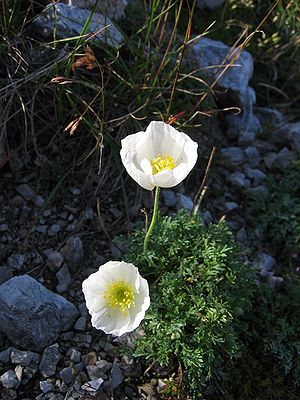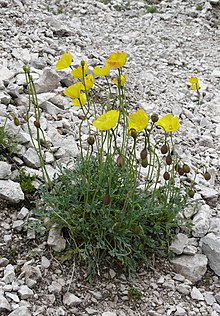Alpine poppies
| Alpine poppies | ||||||||||||
|---|---|---|---|---|---|---|---|---|---|---|---|---|

White Alpine poppy ( Papaver alpinum subsp. Sendtneri ) |
||||||||||||
| Systematics | ||||||||||||
|
||||||||||||
| Scientific name | ||||||||||||
| Papaver alpinum | ||||||||||||
| L. |
The alpine poppy ( Papaver alpinum ) is a type of plant from the genus poppy ( Papaver ) within the family of the poppy plants (Papaveraceae). This species includes several subspecies, four of which are found in Austria .
description

Vegetative characteristics
The Alpine poppy is a perennial herbaceous plant that reaches heights of 5 to 20 centimeters. Each plant specimen can have several upright and hairy stems . As with all types of poppy, a white milky sap appears if the stem is damaged . The leaf rosettes form strong clumps . The leaves are all basal and unpinnate once or twice.
Generative characteristics
The flowering period extends from July to August. The flowers are initially nodding and later erect. The hermaphrodite flowers are radially symmetrical with a diameter of up to 5 centimeters . The two sepals fall off when the bud is opened. There are four white or yellow petals .
A capsule fruit is formed.
There is diploidy and the chromosome number of all subspecies occurring in Europe and already examined is 2n = 14.
ecology
The Alpine poppy is a hemicryptophyte . All alpine poppy forms have a strong tap root and are good dammers. Towards the top, the plant secures itself with uphill fibers.
The fragrant flowers have no nectar , but plenty of pollen .
Locations
The alpine poppy occurs in open rock debris at the alpine level . It thrives on sunny, fresh, agitated lime- scale rubble heaps , is a rubble crawler and rubble dam . It is a character species of the Thlaspietum rotundifolii.
Systematics and distribution




The first publication of Papaver alpinum took place in 1753 by Carl von Linné in Species Plantarum , 1, page 507. The specific epithet alpinum means "from the Alps".
The species group Papaver alpinum aggr. contains several species which some authors consider to be the subtaxa of Papaver alpinum .
According to some authors, there are several subspecies of Papaver alpinum :
Northeast Alpine poppy or Burser's Alpine poppy ( Papaver alpinum subsp. Alpinum , Syn .: Papaver burseri Crantz ) has two- to three-pinnate leaves with white flowers and is endemic to the north-eastern Limestone Alps. In Austria scattered in Lower Austria, Upper Austria and Styria. In Germany only finds from the Oberstdorf mountains are known.
Slovenian Alpine poppy ( Papaver alpinum subsp. Ernesti-mayeri Markgr. ) Was described as a special subspecies in 1958. It occurs in Slovenia and Italy.
Kerner's alpine poppy or Karawanken alpine poppy or Illyrian alpine poppy ( Papaver alpinum subsp. Kerneri (Hayek) Fedde , Syn .: Papaver kerneri Hayek ) has two- to three-pinnate leaves with yellow flowers and is scattered in the southeast Limestone Alps, with a main distribution in the Alps of Slovenia . In Austria only in southern Carinthia.
The Rhaetian Alpine poppy , Yellow alpine poppy ( Papaver alpinum subsp. Rhaeticum (Leresche) Nyman , Syn .: Papaver rhaeticum Leresche ) has yellow to orange-yellow petals with pinnate foliage leaves and is in the Central Alps and the Southern Limestone Alps common. In Austria scattered in Carinthia, Salzburg and Styria, in Switzerland allegedly only in the Engadine . In Germany there are only finds in the Berchtesgaden Alps . Occurrences are also reported from France and Slovenia .
The white alpine poppy , Sendtner alpine poppy , Salzburg alpine poppy ( Papaver alpinum subsp. Sendtneri (A.Kern. Ex Hayek) Schinz & R.Keller , Syn .: Papaver sendtneri A.Kern. Ex Hayek ) has also simply pinnate leaves and white flowers. This subspecies occurs only in the northern Alps or northern Limestone Alps ( Pilatus to Dachstein Mountains ). Movable limestone rubble , scree, limestone or dolomite at altitudes of 1,300 to 2,600 meters are preferred as locations . Although the protected plant occurs only sparsely or rarely, it is the most common white flowering poppy in the Alps. In Austria it occurs scattered in Tyrol, Vorarlberg, Upper Austria, Salzburg and Styria. In Germany, the species occurs only in the high altitudes of the Allgäu and Berchtesgaden Alps and in the Wetterstein and Karwendel mountains. Here the species is partially impaired by high-altitude sheep grazing and excessive game stocks. In Bavaria this subspecies is listed in the “Red List” of endangered plants. Finds are also reported from Switzerland.
Other subspecies in Europe are:
- Papaver alpinum subsp. corona-sancti-stephani (Zapał.) Margrave , occurs only in Romania in the Carpathian Mountains
- Papaver alpinum subsp. degenii (Urum. & Jáv.) Cretziou , occurs only in Italy and in southwestern Bulgaria
- Papaver alpinum subsp. tatricum A.Nyárády , occurs only in Slovakia and Poland.
literature
- Xaver Finkenzeller, Jürke Grau: Alpine flowers. Recognize and determine (= Steinbach's natural guide ). Mosaik, Munich 2002, ISBN 3-576-11482-3 .
- Manfred A. Fischer, Wolfgang Adler, Karl Oswald: Excursion flora for Austria, Liechtenstein and South Tyrol . 2nd, improved and enlarged edition. State of Upper Austria, Biology Center of the Upper Austrian State Museums, Linz 2005, ISBN 3-85474-140-5 .
- Walter Erhardt , Erich Götz, Nils Bödeker, Siegmund Seybold: The great pikeperch. Encyclopedia of Plant Names. Volume 2. Types and varieties. Eugen Ulmer, Stuttgart (Hohenheim) 2008, ISBN 978-3-8001-5406-7 .
- Jaakko Jalas, Juha Suominen (ed.): Atlas Florae Europaeae. Distribution of Vascular Plants in Europe. 9. Paeoniaceae to Capparaceae. Akateeminen Kirjakauppa, The Committee for Mapping the Flora of Europe & Societas Biologica Fennica Vanamo, Helsinki 1991, ISBN 951-9108-08-4 , pages 44-47.
Individual evidence
- ↑ a b Erich Oberdorfer : Plant-sociological excursion flora for Germany and neighboring areas. 8th edition. Verlag Eugen Ulmer, Stuttgart 2001, ISBN 3-8001-3131-5 . Page 426.
- ↑ a b Alpine poppy seeds . In: BiolFlor, the database of biological-ecological characteristics of the flora of Germany.
- ↑ Papaver alpinum at Tropicos.org. Missouri Botanical Garden, St. Louis, accessed February 25, 2018.
Web links
- Papaver alpinum subsp. sendtneri (Hayek) Schinz & Thell., Sendtner-Alpen-Poppy. In: FloraWeb.de.
- Papaver alpinum subsp. rhaeticum (Leresche) Margrave. In: FloraWeb.de.
- Papaver alpinum L., Alpine poppy. In: FloraWeb.de.
- Distribution map for Germany. In: Floraweb .
- Papaver alpinum agg., Species group Alpine poppy. In: FloraWeb.de.
- Papaver alpinum aggr. In: Info Flora , the national data and information center for Swiss flora . Retrieved October 22, 2015.
- Papaver sendtneri Hayek In: Info Flora , the national data and information center for Swiss flora . Retrieved October 22, 2015.
- Papaver occidentale (Markgr.) HE Hess & Landolt In: Info Flora , the national data and information center for Swiss flora . Retrieved October 22, 2015.
- Günther Blaich: data sheet with photos.
- Thomas Meyer: Data sheet with identification key and photos at Flora-de: Flora von Deutschland (old name of the website: Flowers in Swabia ).
further reading
- P. Schönswetter et al. A combined molecular and morphological approach to the taxonomically intricate European mountain plant Papaver alpinum sl (Papaveraceae) - taxa or informal phylogeographical groups? In: Taxon , Volume 58, 2009, pp. 1326-1343.
- Mariam V. Aghababian, 2011: Papaveroideae. : Papaver alpinum aggr. - Datasheet - In: Euro + Med Plantbase - the information resource for Euro-Mediterranean plant diversity .
